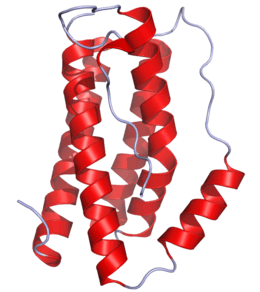IL-6
Interleukine-6 (IL-6) is een eiwit dat wordt gecodeerd door het IL-6 gen.[1]

Functie
IL-6 is een cytokine, betrokken bij zowel pro-inflammatoire als anti-inflammatoire reacties. T-cellen en macrofagen produceren IL-6 om het immuunsysteem te stimuleren bij weefselschade. IL-6 wordt verder ook geproduceerd door spieren als reactie op spiercontractie (cytokines gemaakt door spieren worden ook wel myokines genoemd).[2] IL-6 heeft ook ontstekingsremmende effecten: het remt de functie van TNF-alpha en IL-1 (eiwitten die een stimulerende werking hebben op ontstekingsreacties) en activeert IL-1ra en IL-10 (bekende ontstekingsremmers). IL-6 speelt een belangrijke rol in de koortsreactie. IL-6 kan langs de bloed-hersenbarrière en heeft in de hypothalamus invloed op de lichaamstemperatuur. Macrofagen produceren IL-6 na contact met pathogenen (ziekteverwekkers). Bepaalde delen van pathogenen kunnen herkend worden door herkenningsreceptoren op o.a. macrofagen. De veelgebruikte Engelse term voor deze receptoren is Pattern Recognition Receptor (PRR). Zogeheten toll-like receptoren (TLRs) zijn een type PRR en bevinden zich op celoppervlakken en kunnen na herkenning van ziekteverwekkers een reactie in de cel opwekken die leiden tot de productie van een heel scala aan eiwitten waaronder IL-6.
Rol in ziektes
IL-6 speelt een rol in een aantal ziektes waaronder diabetes,[3] artherosclerose,[4] prostaatkanker,[5] en reumatoïde artritis.[6] Mede daardoor is er veel aandacht voor IL-6 in het wetenschappelijke onderzoek. Ook heeft IL-6 een rol bij de ziekte van Takayasu. Dit is een vasculitis van de grote vaten. Een middel tegen IL-6 is Tocilizumab.
Referenties
- Ferguson-Smith AC, Chen YF, Newman MS, May LT, Sehgal PB, Ruddle FH (April 1988). Regional localization of the interferon-beta 2/B-cell stimulatory factor 2/hepatocyte stimulating factor gene to human chromosome 7p15-p21. Genomics 2 (3): 203–8 . PMID: 3294161.
- Febbraio MA, Pedersen BK (2005) . Contraction-induced myokine production and release: is skeletal muscle an endocrine organ?. Exerc Sport Sci Rev 33 (3): 114–9 . PMID: 16006818. DOI: 10.1097/00003677-200507000-00003.
- Kristiansen OP, Mandrup-Poulsen T (December 2005). Interleukin-6 and diabetes: the good, the bad, or the indifferent?. Diabetes 54 Suppl 2: S114–24 . PMID: 16306329.
- (pl) Dubiński A, Zdrojewicz Z (April 2007). [The role of interleukin-6 in development and progression of atherosclerosis]. Pol. Merkur. Lekarski 22 (130): 291–4 . PMID: 17684929.
- Smith PC, Hobisch A, Lin DL, Culig Z, Keller ET (March 2001). Interleukin-6 and prostate cancer progression. Cytokine Growth Factor Rev. 12 (1): 33–40 . PMID: 11312117.
- Nishimoto N (May 2006). Interleukin-6 in rheumatoid arthritis. Curr Opin Rheumatol 18 (3): 277–81 . PMID: 16582692. DOI: 10.1097/01.bor.0000218949.19860.d1.
Externe links
Leeslijst
- De Kloet ER, Oitzl MS, Schöbitz B (1994) . Cytokines and the brain corticosteroid receptor balance: relevance to pathophysiology of neuroendocrine-immune communication. Psychoneuroendocrinology 19 (2): 121–34 . PMID: 8190832. DOI: 10.1016/0306-4530(94)90002-7.
- Morishita R, Aoki M, Yo Y, Ogihara T (2003) . Hepatocyte growth factor as cardiovascular hormone: role of HGF in the pathogenesis of cardiovascular disease. Endocr. J. 49 (3): 273–84 . PMID: 12201209. DOI: 10.1507/endocrj.49.273.
- Ishihara K, Hirano T (2003) . IL-6 in autoimmune disease and chronic inflammatory proliferative disease. Cytokine Growth Factor Rev. 13 (4-5): 357–68 . PMID: 12220549. DOI: 10.1016/S1359-6101(02)00027-8.
- Culig Z, Bartsch G, Hobisch A (2003) . Interleukin-6 regulates androgen receptor activity and prostate cancer cell growth. Mol. Cell. Endocrinol. 197 (1-2): 231–8 . PMID: 12431817. DOI: 10.1016/S0303-7207(02)00263-0.
- Rattazzi M, Puato M, Faggin E, et al. (2004) . C-reactive protein and interleukin-6 in vascular disease: culprits or passive bystanders?. J. Hypertens. 21 (10): 1787–803 . PMID: 14508181. DOI: 10.1097/01.hjh.0000084735.53355.44.
- Berger FG (2005) . The interleukin-6 gene: a susceptibility factor that may contribute to racial and ethnic disparities in breast cancer mortality. Breast Cancer Res. Treat. 88 (3): 281–5 . PMID: 15609131. DOI: 10.1007/s10549-004-0726-0.
- Stenvinkel P, Ketteler M, Johnson RJ, et al. (2005) . IL-10, IL-6, and TNF-alpha: central factors in the altered cytokine network of uremia--the good, the bad, and the ugly. Kidney Int. 67 (4): 1216–33 . PMID: 15780075. DOI: 10.1111/j.1523-1755.2005.00200.x.
- Vgontzas AN, Bixler EO, Lin HM, et al. (2005) . IL-6 and its circadian secretion in humans. Neuroimmunomodulation 12 (3): 131–40 . PMID: 15905620. DOI: 10.1159/000084844.
- Jones SA (2005) . Directing transition from innate to acquired immunity: defining a role for IL-6. J. Immunol. 175 (6): 3463–8 . PMID: 16148087.
- Copeland KF (2006) . Modulation of HIV-1 transcription by cytokines and chemokines. Mini reviews in medicinal chemistry 5 (12): 1093–101 . PMID: 16375755. DOI: 10.2174/138955705774933383.
- Mastorakos G, Ilias I (2007) . Interleukin-6: a cytokine and/or a major modulator of the response to somatic stress. Ann. N. Y. Acad. Sci. 1088: 373–81 . PMID: 17192581. DOI: 10.1196/annals.1366.021.